Panama: Noonsite’s Panama Canal Transit Guide
Official Noonsite Guide to transiting the Panama Canal by pleasure yacht. Here we outline the procedures for a handline transit of the Panama Canal. Find out what to expect, the paperwork required and how to transit with or without an agent, the equipment and time you will need and – most importantly – the costs.
Published 2 years ago, updated 2 months ago
Panama Canal General Procedures for Small Craft (Handlines)
Small craft vessels up to 38.1 meters (125 feet) in length overall normally transit the Canal as handlines (they do not use locomotives in the locks). Handlines under 20 meters (65 feet) will normally transit the Canal with a transit advisor; while handlines of 20 meters (65 feet) or more will normally require a pilot. See the official Procedures For Securing a Handline Transit document for more detail.
1) Clear into the country of Panama (see Formalities).
2) Obtain an agent or make your own arrangements. See agent information at the bottom of these guidelines and a list of Clearance Agents in Panama Formalities.
3) Register on the Panama Canal online registration system – ASEM. This can be done well in advance of your arrival and a virtual inspection requested and approved (see details below).
4) Once in Canal waters, i.e. Shelter Bay marina or anchorage on the Atlantic side, or, Flamenco marina, La Playita marina or La Playita anchorage on the Pacific side, register and record your arrival on ASEM and request a transit date with the Canal Scheduler. DO NOT DO THIS BEFORE ARRIVING IN CANAL WATERS or you risk being penalized and your booking may be rejected.
AIS is necessary. Canal Authorities and your agent (if you are using one) need to see you to take a screen shot and send it to the Canal Authorities for an arrival record. AIS may soon become mandatory incurring an additional fee of $350.00 per transit for AIS rental.
4) Call Cristobal Signal on VHF Channel 12 on arrival in Canal waters to record arrival time.
5) Contact scheduling department to see if papers generated (may take 24 hrs) and obtain transit schedule.
6) Arrange line handlers (need 4 + Captain).
7) Check or rent your equipment.
8) Collect your Transit Adviser.
9) Transit.
10) Collection of equipment.
Advance Notification and Admeasure Procedure
The Panama Canal Authority requires at least 96 hours advance notification of arrival for vessels wishing to transit.
Advance Notice is made via the ASEM Small Craft Management portal [https://asem.pancanal.com/] which allows skippers to create a profile for their vessel and then provide all the required information for a transit in a virtual environment, doing away for the need for the previous physical measurement and inspection. Use of the online portal is mandatory.
You (or your agent) will need to upload various photos of the boat to demonstrate main measurements and projecting deck equipment, and dimensions will also need to be included. The normal questionnaire asking for arrival date, characteristics, last ten ports, crew details, etc. is also on the portal. Fees are payable through ASEM, by Credit Card or Bank Transfer, the system will give you the two options.
A pre-approval email will be sent to the customer once compiled. If you don’t get a reply of pre-approval from ASEM within 24 hrs, call the admeasurement office.
Southbound – Cristobal: optt-ara@pancanal.com (507) 443-2298
Northbound – Balboa: optc-arp@pancanal.com (507) 272-4571
On Arrival Pre-Transit
Only once you are parked in Canal waters (i.e. Shelter Bay marina or anchorage on the Atlantic side, or, Flamenco marina, La Playita marina or La Playita anchorage on the Pacific side) can you register your arrival via ASEM and request a transit date.
Skippers that do this prior to arriving in Canal waters, are doing so illegally and risk being penalized or even refused transit. Trying to “skip the system” is becoming more common with small craft skippers, and the authorities are considering making AIS mandatory to avoid this (an additional cost of $350.00 to hire AIS for the transit).
Also contact Cristobal Signal on VHF Channel 12 to get your arrival time on the canal system.
Inspection papers will be generated and will be received at the Canal Port Captain office for a final approval prior sending to the canal scheduling department.
Check the following day by calling the canal scheduling office to see if the papers are with the scheduler and request a transit date available on the queue. This may take up to 24 hours after your arrival.
When the inspection is complete you will receive your Panama Canal Ship Identification Number (SIN) which is good for the life of the vessel and an Admeasurement Clearance and Handline Inspection form, which is good for up to six months.
Panamanian Flag
It is mandatory for all vessels transiting the Panama Canal, or while in Panama Canal waters, to display the Panamanian flag. Compliance is expected from all vessels. Non-compliance may result in delays in transit scheduling. This is clearly established in Section 33 of OP Notice to Shipping N-1-2025, and Article 34, Section Four, Chapter I of the Regulation on Navigation in Panama Canal Waters, which says: “All vessels shall display the Panamanian flag from dawn to 1800 hours while they are in Canal waters. However, the vessel may also display their national and house flags.” The Panamanian flag is divided into 4 rectangles of equal size. The hoist side of the flag adjacent to the flag pole is that which has a white rectangle with a blue star at the top and a blue rectangle below it.


Panama Canal Fees
Fees are payable online through ASEM, by Credit Card or Bank Transfer, the system will give you the two options.
Payment will incur a 12.87 % charge by the canal authorities to users.
On July 12th, 2022, following the recommendation from the Panama Canal Authority (ACP), the Cabinet Council of the Republic of Panama officially approved modifications to the Canal Tolls structure. Since 1 January 2023 there has been an annual increase in tolls for yachts transiting the Canal, with the final increase in January 2025.
Transit Tolls for Small Craft:
- Less than 19.812m (65ft): $2,130
- 19.812m-24.384m (65-80ft): $3,200
- 24.384m-30.480m (80-100ft): $4,660
- More than 30.480m (100ft): $6,000
Vessel Scheduling Fee:
(NEW as of January 1, 2025)
To better accommodate vessels that cannot be booked through the regular reservation system, but require coordination with the Canal to be scheduled for transit, the Canal has created the Vessel Scheduling Fee.
- For small vessels (handlines) less than 125 feet: $500
- For vessels 125-300 feet: $6,000
TVI inspection charge:
All vessels $75 (last increase from $54 in April 2021)
Security charge:
All vessels $165 (last increase from $130 in April 2021)
Buffer/Security Deposit:
All vessels $1,060 (last increase from $891 in April 2023)
Additional costs:
- Approx. $100 for the rental of lines and fenders/tyres.
- Adviser’s meal including delivery by launch – meal box $75 and launch service $182 per hour.
- Food and drink costs for the transit crew.
- Transport costs for volunteer line handlers.
- Launch service (for example to bring out a late line handler): $182 per hour.
- Agent (optional) $400-$500 for an agent (plus $100 each for “professional” line handlers). Note no buffer deposit is required.
Additional costs for larger yachts:
- Vessels over 20 meter (65 feet) in LOA must have an AIS, otherwise, the Panama Canal Authority will provide a portable unit and a rental fee of $161 will be assessed.
- Vessels over 125 feet LOA will be subject to a Freshwater Surcharge which will include the following components: a fixed fee of $10,000 per transit and a variable fee ranging from a minimum of one percent to a maximum of 10 percent of the vessel’s toll will be applied depending on Gatun Lake levels at the time of transit (i.e. if the lake has a higher level, the percentage will be lower and vice versa). Also there are Disruption Charges, Suitable Conditions Charges and Green Vessel Classification Charges.
Extra charges or fines:
These can sometimes be incurred during transit, especially if you find yourselves with problems such as engine failure etc. Some examples include:
- US$440 Delay of Transit for not maintaining your nominated boat speed, such as during a breakdown, or for requesting a stop-over in the lake.
- You can pay US$2800 to request a next-day transit
- Note: In the event of having a transit delay or breakdown and requiring shore assistance in canal waters, a registered agent must be contacted to assist with solving the problem and re-scheduling to continue the transit.
The ACP will return your buffer into the appointed bank account. This can happen in a week but might take longer.
Schedule Procedure
Southbound transits (Cristobal – Balboa): Normally start late afternoon, anchoring in Gatun Lake for the night and finishing the following mid-afternoon.
Yachts with higher speed may transit up to Gamboa mooring. Then wait for the following day to complete the transit. Or may transit all the way through in one day as they can keep up a high speed to meet lockage times to tandem with a merchant vessel.
Northbound Transits (Balboa – Cristobal): Normally start around sunrise and finish the same day, late afternoon.
Yachts normally pass through the locks with small commercial ships.
Waiting Times
During the months of February/March there is heavy small craft traffic due to the transiting of World ARC and Carnival Holidays (which means limited canal adviser availability). Yachts can expect a 5-10 day wait after the inspection before transiting.
Line Handler Procedure
The ACP requires that you have four line handlers in addition to the Captain.
Note: It is highly recommended that you join someone else for transit before taking your own yacht through.
- See Mad About Panama for more details on how to find line handlers.
- Panama Canal Linehandler Exchange – WhatsApp Group
- Panama Cruisers Facebook Group
Equipment Procedure
Most boats have to rent large fenders (normally tires wrapped in plastic) and long lines for their transit. If using an agent, this can all be arranged through them and they will collect all items after transit.
However, if using an unofficial agent, or no agent, the person you contract to rent equipment will most-likely only pick up the lines after transit. This has resulted in cruisers throwing away the used tires. Old tires are a mosquito breeding area; so cruisers are asked to make sure any tires and lines are picked up after transit by the person they came from, or to make arrangements to dispose of them properly.
Yachts transiting the Panama Canal should be aware that lines used in transit may well become oily, greasy and/or stained from rusty moorings and dirt from the locomotive railways. Agent Erick Galvez has brought this to the attention of the Panama Canal Authority urging a solution be sought, but yachts transiting should be aware that lines coming back from the wall, or moorings in Gatun, may bring unwanted dirt back to the boat, and appropriate precautions should be taken. All lines provided by the agent may look dirty, but should be clean and are simply stained.
Canal Advisers
The Adviser appointed by the Panama Canal Authority will be on board throughout your transit. It’s important to remember that the adviser is not a Pilot in command, but as the name suggests, an adviser. You may not necessarily choose to take all the advice you are given, but do note most advisers know what can go wrong and how to avoid it. The adviser needs to be given proper, hot meals while on board and bottled water with unbroken seals. If your transit is overnight, he will not stay on board and may not eat an evening meal prior to departure, however be sure to confirm this in advance as if hot food is not provided he will order a meal box which can cost several hundred dollars for the meal and delivery (see notes above under Fees). You may get a different adviser on your second day of transit. Useful blog post by Nica Waters re. food for the transit can be found here.
Restrictions
The optimum minimum speed to transit the Canal is 8 knots. The Canal Authority may deny transit if a handline vessel cannot maintain a minimum speed of 5 knots. However, a vessel may be towed through the Canal by another handline vessel if it can tow her at 5 or more knots, or the vessel owner can make arrangements to be towed, at their own expense, by a Panama Canal Authority launch.
The vessel must be equipped with a working whistle or horn. The vessel must have a toilet and holding the tank onboard (though the holding tank is not always checked). The vessel must provide the Pilot or Transit Adviser with a hot meal and bottled water, or there could be an additional charge to provide these items for them. An awning must be installed over the cockpit to provide the Transit Adviser and crew with shelter from the sun and rain. The vessel must maintain its schedule, regardless of weather conditions.
For further details see the official ACP Procedures For Securing a Handline Transit document.
Types of Lockages
There are four types of lockages available to yachts: center chamber; nested; sidewall; or alongside an ACP Tug.
All vessels will be required to be capable of making a center chamber lockage. The other three options will be at the discretion of the Canal Port Captain.
Sloops may request center chamber or nested and say no to sidewall or alongside a tug.
Catamarans and Motorboats may select center, nested or sidewall and say no to tugs.
Center Chamber:
The vessel is held in the center of the chamber by two bow and two stern lines. This type of lockage requires four 125‐foot lines not less than 7/8” in diameter, nor larger than 1 ½” in diameter.
Nested Center:
This is where two or more vessels (yachts or a ferry boat) perform the entire lockage tied up or “nested” alongside each other.
Sidewall Lockage:
This type of lockage uses two of the required 125‐foot lines to hold the vessel alongside the sidewall in the chamber. The walls of the locks are rough unfinished concrete, which can cause considerable damage to vessels not properly protected by fenders. Damage to masts or rigging on sailboats may also occur if the turbulence causes the vessels to roll and strike the sidewall.
Alongside an ACP Tug:
Availability of this type of blockage depends on the ship traffic for the day, and as such cannot be scheduled.
VHF Channels
Cristobal Signal Station and Flamenco Signal Station Balboa (Panama Canal Authority) listen on Channels 12 & 16 and use these channels for Port and Canal movements.
In the lake VHF is not usable, only mobile phone.
Agents
Agents are optional and arranging your own transit is a straightforward process. However, the service of agents is available if you don’t want to do the paperwork for the transit yourself or if you have special timing requirements. The extent of the service depends on the captain’s requirements and negotiations with the agent.
Note that there are official agents, registered with the Canal Authorities, and unofficial “agents”, who in the main are taxi drivers. Non-registered agents are no longer a good option, as they will be held responsible if they register in the ASEM platform.
A few things to consider if using an agent:
- If Transit Fees and Buffer (Guarantee Deposit) is paid via the agent and not directly, it should be made clear beforehand how and when the Buffer is refunded or accounted for.
- Daily rate for line handlers – don’t forget to take into account the number of days your transit is expected to take.
- Experience of line handlers and possible language barrier.
In the event of having a transit delay or breakdown and requiring shore assistance in canal waters, a registered agent must be contacted to assist with solving the problem and re-scheduling to continue the transit. Do your research and have an agent in mind should you need to contact them mid-transit for breakdown reasons. Note: when in the lake VHF is not reachable only mobile phone can be used for communications.
Links:
- The website Mad About Panama has excellent information as well as a regularly updated Ebook covering all aspects of a yacht transit.
- The official Panama Canal website has forms and reference documents, such as “Procedures for Securing a Handline Transit” and “Request for Transit Booking”.
- Panama Canal Linehandler Exchange – WhatsApp Group
- Panama Cruisers Facebook Group
Related content:
- Latest Panama Canal News on Noonsite
- Scheduling and Last Minute Services – Rules and Procedures (December 24, 2024)
- Panama Canal Authority Advisory A-31-2024 (August 28, 2024) announces modifications to the transit reservation (Booking) system and new tariffs as of January 1st, 2025.
- Panama Canal: Conditions Slowly Returning to Normal (June 2024)
- New Panama Canal Portal for Small Craft Inspection (July 2023)
- Panama Canal Prepares for Impact of Climate Events (July 2023)
- Panama Canal: Tips for Transit
- Panama Canal Transit Food (Feb. 2025)
- Panama Canal: A Shortcut Between the Seas (transit Dec. 2021)
- Panama Canal Transit: Covid-19 Field Report (transit April 2020)
- A Transit in High Season Without Using an Agent (transit Feb. 2020)
- Cristobal (Colon) Port page
- Balboa Port Page
Last updated: May 2025
Related to following destinations: Balboa, Caribbean, Cristobal (Colon), Pacific (Panama), Panama









Although I usually do my own paperwork when dealing with entry, exit and other formalities, I am very happy I chose an agent for the canal transit. He ended up saving me quite a bit of money by processing a in-transit visa which negated the need for a cruising permit, and was reasonable with the line handlers he provided, charging one rate regardless of whether it was a one or two days transit and selecting very high quality experienced handlers. The lines and fender balls he supplied were clean. Most of all, his responses to my numerous questions were almost immediately responded to and when he needed to, would pick up the phone and further explain any questions or confusions I had. I highly recommend Roy Bravo, Whatsapp +507 6678-6820.
Update on PANAMA CANAL TRANSIT SITUATION (EL NIÑO PHENOMENON) from Associated Yacht Services:
Effective July 30th 2023, due to low water levels at Gatun Lake resulting from the ongoing El Niño phenomenon, the Canal Authority is only transiting an average of 32 vessels per day until Sept 2024.
Presently Panama Canal transit delays for unbooked vessels are running very high in the range 16 to 19 days (delays subject to vessel’s size).
Draft restricion in the New locks for bigger ships (Neopanamax locks) still stands at 44 feet. No Draft restriction in the Old locks at the moment.
As for Yachts arriving and transiting because of the Yacht size/length (smaller than commercial ships) delays should be less, however can expect unbooked delays in the range of 2 to 6/7 days subject to changes and latest Canal situation – which changes daily.
For Yachts over 125 feet that use Locomotives and Panama Canal Linehandlers that transits can be Booked for a specific day, the Booking slots for the months of August and September are running out. We strongly suggest to check with your agent in time if you are planning to transit the Canal soon, as conditions will change as well as the amount of Booking slots.
Delays for Yachts less than 125 feet are not running too high at this moment.
The Panama Canal has confirmed a Lane Outage at Pedro Miguel Locks (only the West Lane) from May 9th until May 16th (8 days) as per
Advisory To Shipping No. A-19-2023. Significant delays in unbooked vessels will be expected during this period and several days after the maintanance is completed. Booking a slot is only possible for boats 125ft and over and costs US$10,500.
From Erick Galvez, agency Centenario & Co SA:
FOR YOUR INFORMATION, SAILORS TO TAKE PRECAUTION AT THE GATUN MOORING (V. RUSTY) AND BE AWARE THAT ALTHOUGH WE WASH ALL OUR LINES AFTER USE, SOME STAIN WILL NOT COME OFF FROM THE LINES. SKIPPERS MAY NOTICE THE STAIN WHEN WE HAND OVER LINES, BUT THEY WILL NOT DIRTY YOUR BOAT. HOWEVER DURING TRANSIT LINES MAY COME BACK WITH FRESH GREASE FROM THE WALL AND DIRTY THE BOAT. TAKE THE NECESSARY PRECAUTIONS.
The Panama Canal has scheduled a locks maintenance outage in Gatun locks from July 5th to July 14th (10 days). Significant Panama Canal delays of several days will be expected during this period. If considering transiting the canal during this period it is recommended to book a slot ASAP to avoid delays.